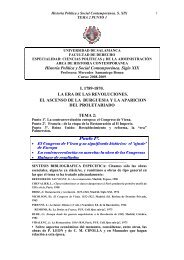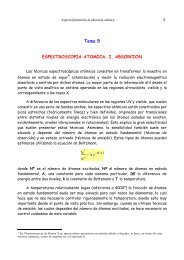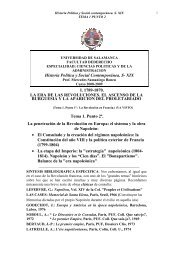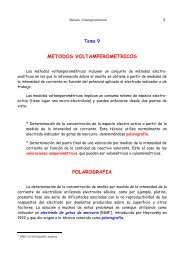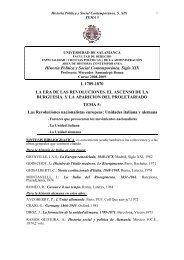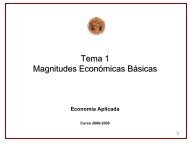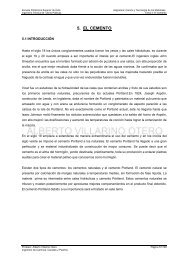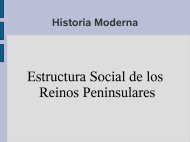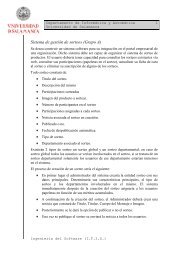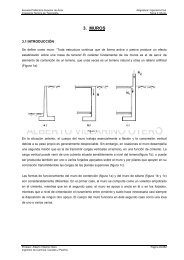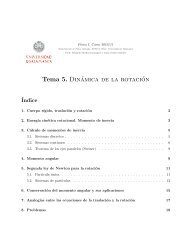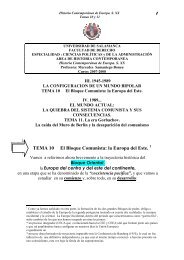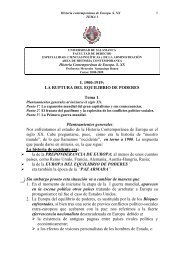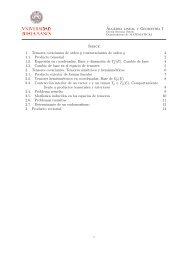TEMA 6. Programación No Lineal. Métodos de ... - OCW Usal
TEMA 6. Programación No Lineal. Métodos de ... - OCW Usal
TEMA 6. Programación No Lineal. Métodos de ... - OCW Usal
Create successful ePaper yourself
Turn your PDF publications into a flip-book with our unique Google optimized e-Paper software.
190 Investigación Operativa<br />
i 0 (i=1, 2, ..., m)<br />
j 0 (j=1, 2, ..., n) (<strong>6.</strong>8)<br />
Tomaremos en la expresión anterior el signo:<br />
(-, +) para un problema <strong>de</strong> maximización.<br />
(+, -) para un problema <strong>de</strong> minimización.<br />
Como j 0, la primera restricción <strong>de</strong> (<strong>6.</strong>8) pue<strong>de</strong> escribirse como<br />
m<br />
f ( x)<br />
- x<br />
<br />
j<br />
j<br />
i 1<br />
m<br />
f ( x)<br />
+ x<br />
<br />
i 1<br />
i<br />
i<br />
gi<br />
( x)<br />
x<br />
j<br />
j<br />
0 (j=1, 2, ..., n) (problema <strong>de</strong> maximización)<br />
gi<br />
( x)<br />
0 (j=1, 2, ..., n) (problema <strong>de</strong> minimización)<br />
x<br />
Generalizando los Teoremas <strong>6.</strong>11 y <strong>6.</strong>12, tenemos:<br />
Teorema <strong>6.</strong>13. Sea el problema (<strong>6.</strong>7) <strong>de</strong> maximizar f(x). Si el punto<br />
x =( x 1 , x2,...,<br />
xn<br />
) es una solución óptima <strong>de</strong> (<strong>6.</strong>7), entonces x tendrá que<br />
satisfacer las m restricciones <strong>de</strong>l problema <strong>de</strong> PNL (<strong>6.</strong>7) y <strong>de</strong>berán existir<br />
multiplicadores 1, 2, …, m; 1, 2, …, n, que verifiquen las condiciones<br />
<strong>de</strong> Kuhn-Tucker (<strong>6.</strong>8).<br />
Teorema <strong>6.</strong>14. Sea el problema (<strong>6.</strong>7) <strong>de</strong> minimizar f(x). Si el punto<br />
x =( x 1 , x2,...,<br />
xn<br />
) es una solución óptima <strong>de</strong> (<strong>6.</strong>7), entonces x tendrá que<br />
satisfacer las m restricciones <strong>de</strong>l problema <strong>de</strong> PNL (<strong>6.</strong>7) y <strong>de</strong>berán existir<br />
multiplicadores 1, 2, …, m; 1, 2, …, n que verifiquen las condiciones <strong>de</strong><br />
Kuhn-Tucker (<strong>6.</strong>8).<br />
Po<strong>de</strong>mos establecer dos teoremas, correspondientes a los Teorema <strong>6.</strong>13 y<br />
<strong>6.</strong>14, que recojan las condiciones necesarias y suficientes para que<br />
x =( x 1 , x2,...,<br />
xn<br />
) sea una solución óptima <strong>de</strong> (<strong>6.</strong>5) o (<strong>6.</strong>7).<br />
Teorema <strong>6.</strong>15. Sea el problema (<strong>6.</strong>7) <strong>de</strong> maximizar f(x). Si f(x) es una<br />
función cóncava y las gi(x) (i=1, 2, ..., m) son funciones convexas, entonces<br />
cualquier punto x =( x 1 , x2,...,<br />
xn<br />
) que satisfaga las condiciones <strong>de</strong> Kuhn-Tucker<br />
(<strong>6.</strong>8) y las m restricciones <strong>de</strong>l problema <strong>de</strong> PNL es una solución óptima <strong>de</strong> (<strong>6.</strong>7).



